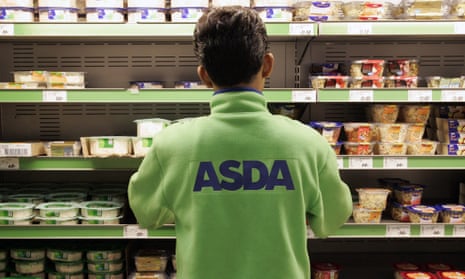Asda has reported its first quarterly rise in sales for three years as the UK’s third largest supermarket chain said customers were responding to price cuts and store improvements.
Sales, excluding petrol, rose 1.8% in the three months to the end of June partly thanks to a boost from Easter trading.
While Asda flagged its strategy of cutting prices on key items, a return to grocery price inflation spurred by the fall in the value of sterling is also likely to have helped the chain, owned by US retailer Walmart.
Supermarkets have been struggling to cope with the rapid expansion of discounters Aldi and Lidl in the UK, which forced them to cut prices on many everyday basics.
Asda said trading was particularly strong over Easter, with sales up 16%. Adjusting for the timing of the holiday, sales at established stores were up by 0.7% on the same period last year.
Industry watchers said the results were cheering for Walmart. “While this comes off the back of a 7.5% decline in the prior year, it is nevertheless an early sign that Walmart is addressing some of the issues that have long since plagued the UK operation,” said Neil Saunders, the managing director of market research firm GlobalData Retail.Walmart’s president and chief executive, Doug McMillon, said he was encouraged by the UK arm’s performance. “In June, I visited Asda to see the progress being made. Customers are responding to investments in price and store experience by visiting the stores more often and increasing their basket sizes,” he said. “There’s still much more to be done, but we’re clearly headed in the right direction.”
The company said there had been improvements in customer numbers and spending. But Walmart’s figures indicated that Asda’s sales rise had partly been at the expense of profits, with operating income and gross margins down during the quarter.
Asda’s president and chief executive, Sean Clarke, said: “Our continued focus on delivering great value and service meant 275,000 new customers chose to shop at Asda in the second quarter, particularly during Easter.
”We will continue to work collaboratively with our suppliers to create the best products, make investments where they matter most to our customers, and ensure that we are fit for purpose in what remains a competitive market.”
The recent improvement in trading comes after Asda posted its worst annual figures since being taken over by Walmart in 1999, as fierce competition in the UK supermarket sector took its toll.
The supermarket chain admitted its performance was “behind expectations” after pre-tax profit for 2016 fell 19% to £791.7m. Accounts filed at Companies House also showed sales fell to £21.6bn from £22.3bn.
All the “big four” grocers - Tesco, Sainsbury’s, Asda and Morrisons - have suffered from upheaval in the industry in recent years. Many consumers are swapping their weekly shop for more frequent visits to small local stores as they try to save money or cut down on food waste. The rise of online shopping has also hit large supermarkets who have been forced to cut costs as a result.
Last week, it emerged that thousands of Asda workers were facing redundancy or a dramatic cut in their working hours as it looks to cut costs.

Comments (…)
Sign in or create your Guardian account to join the discussion